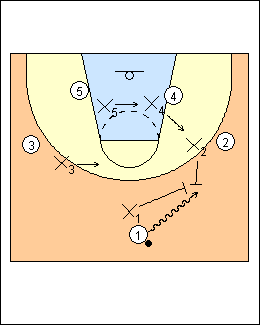 | 1 Midcourt trap Used in short intervals to change tempo, disrupt the half-court attack, and get the ball away from the point guard. X1 picks up the ball at midcourt and forces O1 to one side. When the dribbler is 3 strides away, X2 completes the trap by running under control with hands up towards the dribbler's outside shoulder (making it more difficult to avoid or pass over the trap). X2 is replaced by the nearest teammate, who is often in the best position to steal and is in turn replaced by another defender. Here X4 rotates to prevent a pass to X2's man. Weakside helper X5 rotates to prevent a pass to the ballside post, but is also the safety protecting the basket in the gap between O4 and O5. X3 continues to deny a pass to O3. |
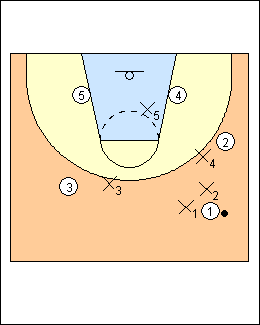 | 2 These are the positions once the trap is set and rotation has occurred. X1 and X2 form a V pointing away from the basket, and are toe-to-toe so that O1 can't step through and split the trap. X3 and X4 are interceptors and X5 is the safety. O5, the attacker furthest from the trap, may be left open, but it is a tough pass under pressure. If the attackers complete a pass out of the trap, the defenders must recover to their checks as quickly as possible (sprint out of traps), and be prepared to defend temporarily in a disadvantage (outnumbered) situation. The easiest rotation may be for the trapper to pick up the nearest open attacker. |
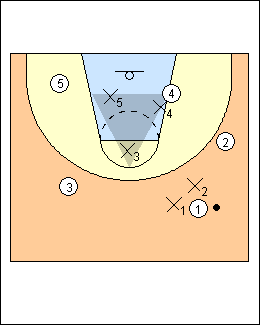 | 3 If traps are intended to contain and slow down the attackers, rather than to intercept passes, the defenders not involved in the trap create a defensive triangle to protect the basket. Here X4 would not rotate up to pick up O2, and X3 would sag off to the foul line. |
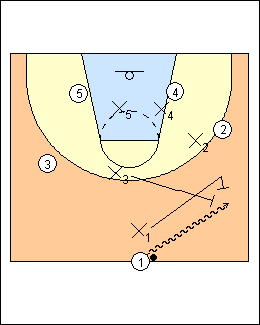 | 4 Variations - X3 comes across to trap with X1, other defenders do not need to rotate on the trap (O3 is left open) - a specific player is designated to trap with X1, e.g., X4 or X5 (Red Rover 4 or 5). |
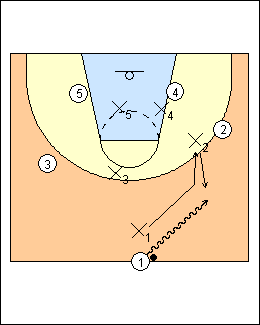 | 5 Run and jump switch A jump switch can be an effective option after trapping a few times. When X2 reaches the dribbler, X1 does not trap with X2, but rather runs through to pick up X2's man. X1 and X2 switch. Because this is a two-player tactic, there is no rotation or adjustment by the other defenders. It can be called from the bench, or X2 would yell "jump" to signal that X1 should jump switch. |
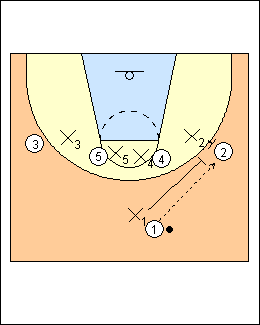 | 6 Entry pass The wing entry pass is allowed. As the pass is released the defender of the passer follows to trap the receiver. Can be used against a 1-4 set that is trying to set up backdoor opportunities by getting the wing defenders to overplay. |
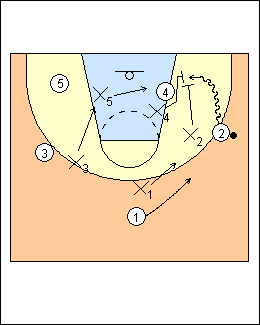 | 7 Baseline Trap If the ball is on the wing, the on-ball defender forces the ballhandler to the corner, or to a baseline cut-off point one step outside the international lane (the short corner). An automatic trap takes place if the dribbler penetrates inside the cut-off point. The ballside post defender moves to trap and is immediately replaced by weakside helper X5, and weakside wing X3 drops down to pick up X5's check. X1 is not involved in the rotation, and continues to prevent a pass to O1. |
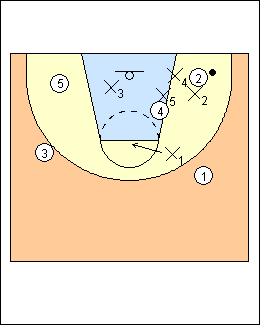 | 8 Here are the positions after trapping and rotating. Attacker O3, furthest from the ball, is not guarded. If the attackers show that they can hit the open player, or for containment, X1 would move to the foul line to create a defensive triangle with X3 and X5, and attempt to cut off passes to both O1 and O3 by playing in the gap between them. |
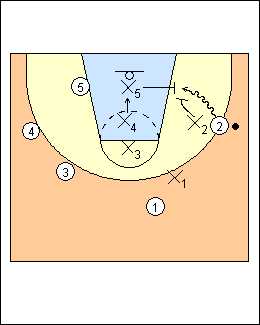 | 9 Where the ballside low post is open, help defender X5 traps with X2 if ballhandler O2 penetrates the baseline cut-off point. X4 rotates down to cover O5. |
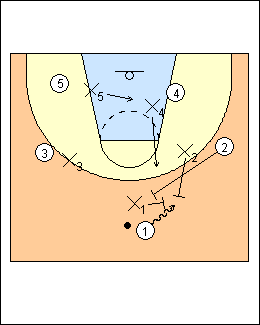 | 10 Ballscreen Trap Automatic trapping can also be used to defend a ballscreen (pick and roll). The defender on screener O2 traps as ballhandler O1 draws even with the screen. The screener is picked up by the nearest defender and the defence rotates to leave the least dangerous player open. |
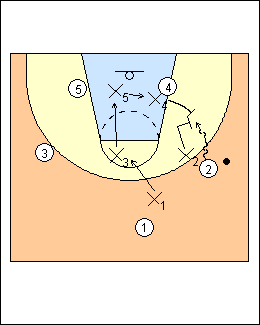 | 11 Sideline Trap For short intervals, an early sideline trap can be used as an alternative to the baseline trap. As soon as the ball is dribbled or received below the free-throw line extended, the nearest defender steps out to make a sideline trap with the on-ball defender, and the other defenders rotate to create a defensive triangle. |
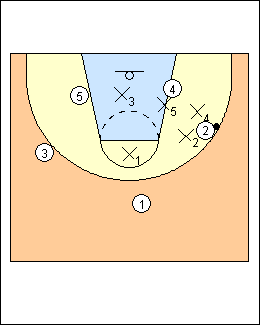 | 12 Here are the positions after rotation. |
This page was made with Basketball playbook from Jes-Soft